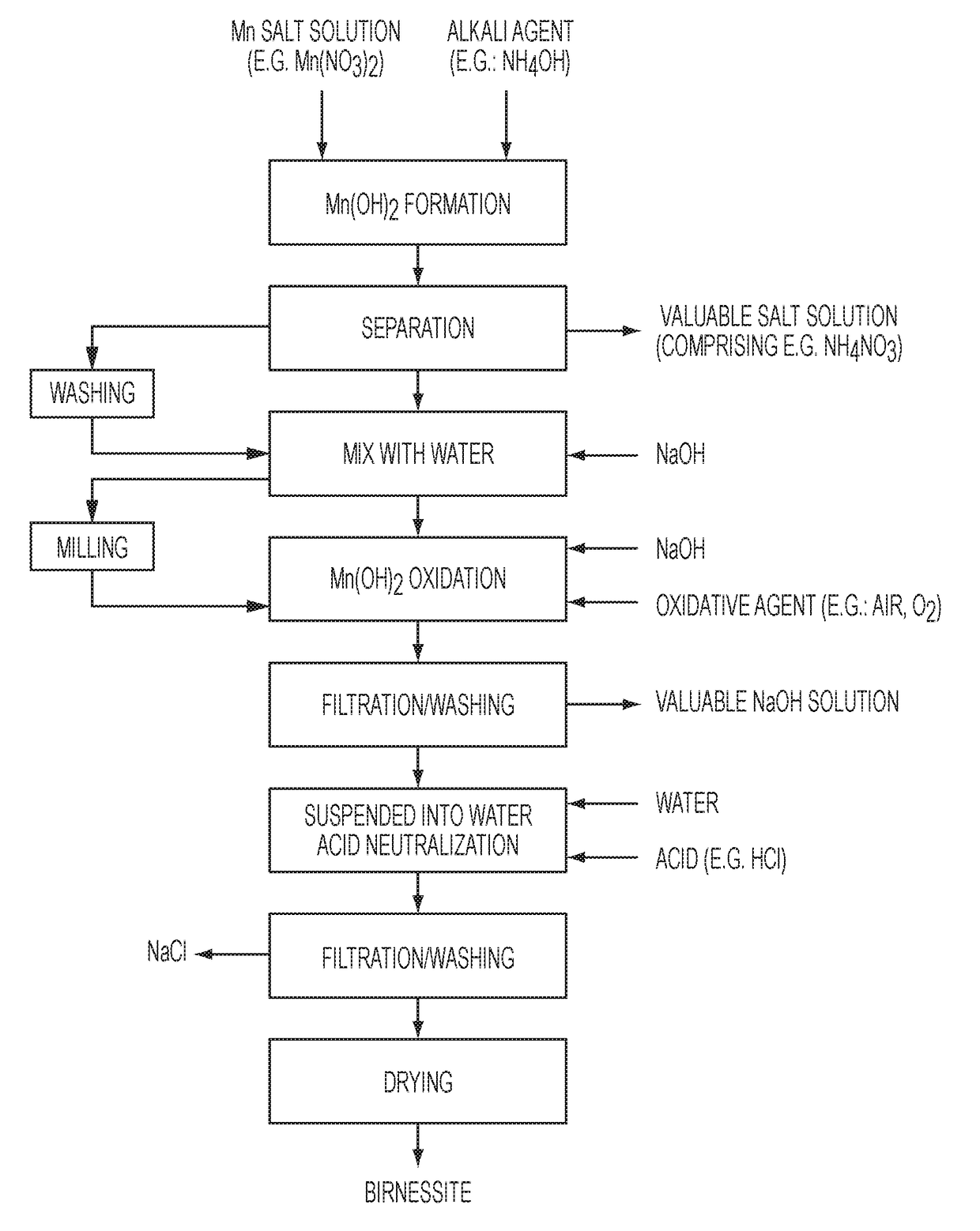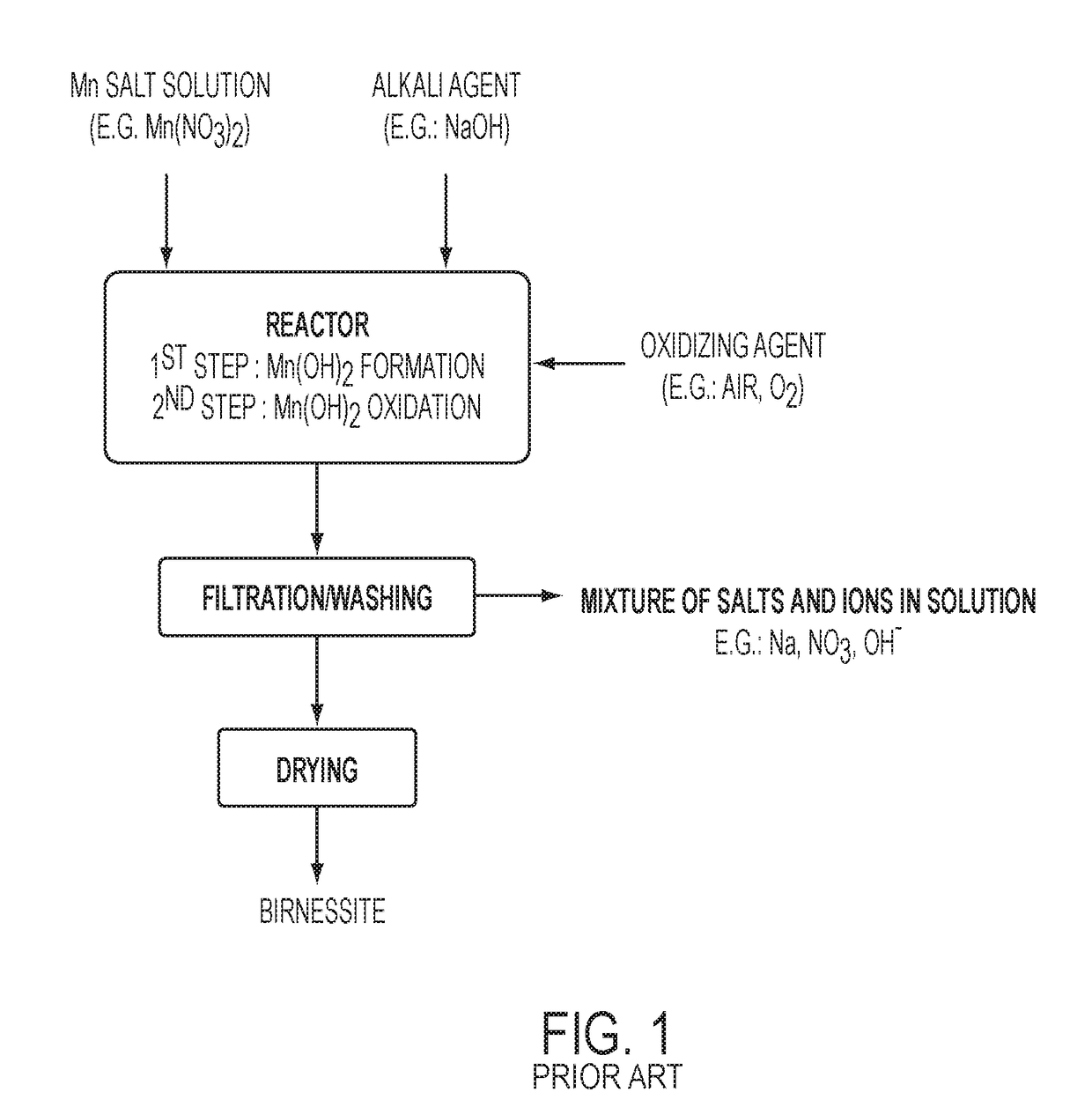Highly Pure Birnessite and Method for the Production Thereof
a technology of birnessite and birnessite, which is applied in the direction of manganates/permanentates, physical/chemical process catalysts, metal/metal-oxides/metal-hydroxide catalysts, etc., can solve the problems of large quantities of water needed to dissolve and remove undesirable salts, and the salts have little or no economic valu
- Summary
- Abstract
- Description
- Claims
- Application Information
AI Technical Summary
Benefits of technology
Problems solved by technology
Method used
Image
Examples
example 1
[0052]Demineralized water (300 ml) was introduced into an agitated reactor having a volume of 4 liters. The liquid was agitated with a 2 blade stirrer at a stirring speed of 70 rpm. An aqueous manganese nitrate solution having a manganese content of 1.20 grams per liter and an aqueous ammonium hydroxide solution having an ammonia content of 230 grams NH3 per liter were simultaneously introduced into the reactor at constant flow rates for 75 minutes to produce a solution having a hydroxide group to manganese ratio of 2.05. The reactor temperature was not controlled, and it reached about 24° C. after the introduction of reactants. After introduction of the aqueous manganese nitrate solution and the aqueous ammonium hydroxide solution to the reactor was completed, stirring of the solution was continued for 20 minutes to complete the formation of manganese hydroxide.
[0053]The solution was filtered on a Buchner filter and the filter cake was washed on the filter using 3 liters of deminer...
example 2
[0059]Demineralized water (300 ml) was added into an agitated reactor having a volume of 4 liters. The liquid was agitated with a 2 blade-stirrer at a stirring speed of 25 rpm. An aqueous manganese nitrate solution having a manganese content of 120 grams per liter and an aqueous ammonium hydroxide solution having an ammonia content of 230 grams per liter were simultaneously introduced into the reactor at constant flow rates for 75 minutes to produce a solution having a hydroxide group to manganese ratio of 2.05. The reactor temperature was controlled at 20° C. After introduction of the aqueous manganese nitrate solution and the aqueous ammonium hydroxide solution to the reactor was completed, stirring of the solution was continued for 20 minutes to complete formation of manganese hydroxide.
[0060]The solution was filtered on a Buchner filter and the filter cake was washed on the filter using 3 liters of demineralized water. The filtrate was a solution of ammonium nitrate that can be ...
example 3
[0066]An oxide of manganese was produced using the same parameters as Example 2 except the sodium hydroxide concentration in the oxidation reactor was 2 moles per liter. The resulting oxide of manganese was characterized as shown in Table 1.
PUM
| Property | Measurement | Unit |
|---|---|---|
| Temperature | aaaaa | aaaaa |
| Temperature | aaaaa | aaaaa |
| Temperature | aaaaa | aaaaa |
Abstract
Description
Claims
Application Information
 Login to View More
Login to View More - R&D
- Intellectual Property
- Life Sciences
- Materials
- Tech Scout
- Unparalleled Data Quality
- Higher Quality Content
- 60% Fewer Hallucinations
Browse by: Latest US Patents, China's latest patents, Technical Efficacy Thesaurus, Application Domain, Technology Topic, Popular Technical Reports.
© 2025 PatSnap. All rights reserved.Legal|Privacy policy|Modern Slavery Act Transparency Statement|Sitemap|About US| Contact US: help@patsnap.com



